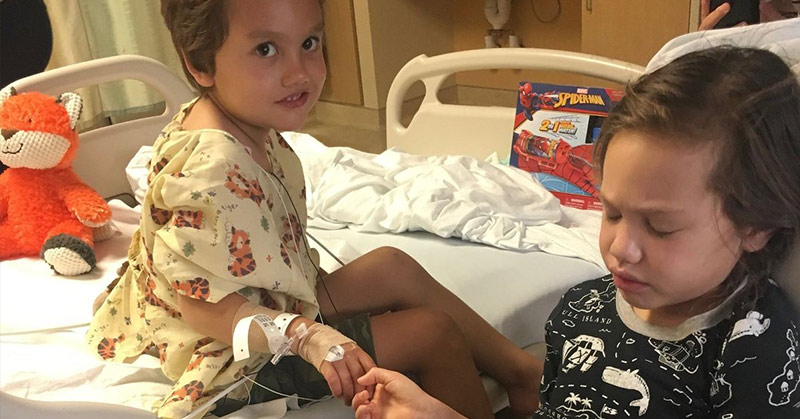A couple in Torrance, Los Angeles probably had the worst two weeks of their lives when both of their children were diagnosed with brain cancer. Duncan and Nohea Avery were terrified when their 6-year-old princess, Kalea was diagnosed with medulloblastoma, a deadly and aggressive brain tumor. Two weeks after her diagnosis and surgery, the high school surf coach and practicing nurse received another devastating shock. Their 4-year-old, Noah, was also diagnosed with the exact same kind of tumor. Even the doctors admitted they’d never seen such horribly timed occurrences before.
Kalea’s diagnosis
Kalea had been playing cheerfully with her cousins on Memorial Day Weekend in May 2018. She threw up after some time, and her parents thought she just had a minor stomach upset. She carried on with her day and even went skateboarding with her father, an activity she loves passionately.
A few days later, she complained of a painful ache between her eyebrows. It got so bad that her mom had to take her to the hospital to get looked at.
After a series of tests and an MRI, she was diagnosed with medulloblastoma, an aggressive cancerous tumor. It starts at the base of the skull and spreads to other parts of the brain and into the spinal cord. This tumor is the most common cancerous brain tumor that develops in children [1].
In an interview with LA Times, 36-year-old Duncan explained that the diagnosis badly broke his heart and turned their lives upside down [2]. “In just a few weeks, we go from having a healthy baby girl who’s a skateboarder and a soccer player, who’s just loving life, to having a tumor removed from her brain.”
Noah’s diagnosis
According to their parents, Kalea and Noah share a strong, loving bond. The two kids are “100% percent best friends”, as their dad described. Noah fiercely looks up to Kalea, and that was why his parents thought he was copying her when he complained of the same headache.
Just like Kalea, Noah experienced nausea and the same pain between his eyebrows. His body movements became uncoordinated as well, and he slept a lot more than usual. His father assumed it all to be signs of early depression, which wasn’t strange since his dear sister was sick and in severe pain. To be on the safe side, the little boy was taken to the hospital to get checked out.
After his own MRI, Noah’s tumors were found to be actually larger than Kalea’s. Their parents couldn’t believe it when they were informed. It seemed as if the world has come crashing down on their heads.
Dr. Lauren Nguyen, the Avery family pediatrician said she was heartbroken when she saw Noah’s unstable gait.
“When I watched Noah walk down the hall, my heart dropped,” she said. “But, of course, could lightning strike twice? It’s very unusual. It could be random, but probably not.”
Hope for Kalea and Noah
Kalea and Noah are a rarity in brain tumor history. Doctors are yet to discover how they could both develop the same malignant brain tumor within two weeks of each other. The doctors are working on their family history to confirm possibilities of gene mutation. There have been cases of siblings developing similar brain tumors, but the tumors mostly occur years apart. The two-week interval between Kalea and Noah is beyond the comprehension of even the most experienced doctors.
Dr. Ramin Javahery, director of pediatric neurosurgery at Miller Children’s & Women’s Hospital, Long Beach, removed Noah’s tumor a few days later. The doctor had been stunned when he got wind of the situation.
“I thought, ‘Huh, same last name, how odd,’” Javahery said. “It was just so not within my thought processes that you could have her sibling coming in. I assumed it was someone else. … Then I was told by the oncologist about what was going on, and I’m like, ‘Oh, my God.’”
The children will have to undergo extensive chemotherapy and radiotherapy for a while. While chemo on its own is painful and gut-wrenching, the radiotherapy procedure is the more serious cause of concern.
UCLA Pediatrician Dr. Anthony Wang gave an insight into the negative effects of radiation. “With radiating young children, you can essentially affect every part of the brain, but the way it manifests is most importantly cognitive. It severely delays cognitive development,”
Due to their young and fragile ages, they may also require speech, occupational, and physical therapy in the future. The doctors say they each have an 80% chance of making it through the first five years. If the tumors don’t return after this period, it’s likely they’ll stay in remission and never come back.

